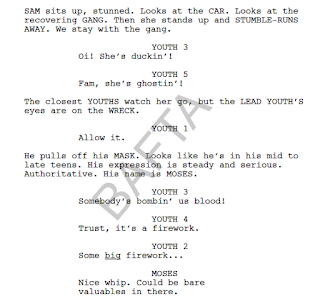UTOPIA (2013-14)
Critical Review
One of the initial aspects of the series that
stood out to me its cinematography. The colour palette used is extremely
saturated, replicating a bold aesthetic used by the graphic novel the series is
based on. In order to achieve this, director Marc Munden referred to the Technicoulor
of 1950’s Hollywood, explaining; "We chose certain colours like yellow and
turquoise and painted them into the shots afterwards. The skies that we shot
weren't always blue, they were mostly grey British skies. The same goes for
making grass greener, eyes brighter, or turning a blue van yellow."
(Wired, 2014) This is an interesting stylistic decision for the series, as the
narrative’s themes of the series itself are extremely dark, with the
protagonists combatting hyper-violence, sterilisation and mass murder. However,
“UTOPIA” discusses ideas of creating a new Utopian society, and the individuals
within The Network’s dedication to
this moral ideology. Perhaps this links to the idea of modernism, and the
rejection of traditional convention to create the “new” - using expressionism
to conceive a bright future. Therefore, this dedication to a unique colour
palette not only reflects the series’ central theme, but also suggests a reinvention
of society by going against traditional convention in Western media (in this
case, colour in Television).
Word Count: 500
Critical Review
UTOPIA, created by Dennis Kelly is a British
thriller, first aired on Channel 4 in
2013. The story follows a small group of people
who find themselves in possession of the manuscript sequel of a graphic novel
called The
Utopia Experiment - rumoured to have predicted the worst disasters of the
last century.
 |
| Examples of cinematography from the series |
Similarly to the cinematography, UTOPIA’s sound design is also very
unique. Its non-diegetic soundtrack combines sounds from the show (for example
sound effects such as breathing, or lines of dialogue) with exotic instruments
and dissonant tones to create the perfect atmosphere of unease and dislocation:
Rob Smedley describes the soundtrack itself as “resulting
in an experience that’s unique to TV composition, like a gallery of modern art
it bypasses your logic centres and goes straight for a gut reaction.” (Cultbox,
2013) Despite using extracts from the series itself, the music rejects all
conventional musical structures such as key or time signatures, creating a
lucid, dream-like feel - distorting what the audience conceives to be real
within the series. When accompanying a scene, therefore, the soundtrack creates
a sense of surrealism, creating a juxtaposition between the real (visual) and the
distorted (aural) - again adhering to the narrative itself, which focuses around
a vision of the future coming into reality.
In conclusion, UTOPIA (2013-14) is a Series unique from
many airing currently, setting itself aside from others of its genre as it
utilises the basic elements of narrative depiction through moving image (i.e.
camera, sound, mise-en-scene and editing) to create its own unique aesthetic
style; and comment on modern society as it stands today, focusing on current
themes and applying a sense of realism to the story – forcing an audience to engage
and wonder about their own future.Word Count: 500
Bibliography:
Wired. (2014)
http://www.wired.co.uk/article/utopia-channel-4
BBC iPlayer.
(2005) http://www.bbc.co.uk/programmes/p003k9fz
Fiegel, Lara.
(2011) https://www.theguardian.com/artanddesign/2011/sep/11/british-architecture-modernism
Smedley, Rob.
(2013) http://www.cultbox.co.uk/reviews/soundtracks/utopia-series-1-soundtrack-album-review
Tapia de
Veer, Christopal. (2013) https://soundcloud.com/cristobal-tapia-de-veer/utopia-1?in=cristobal-tapia-de-veer/sets/utopia-1

















